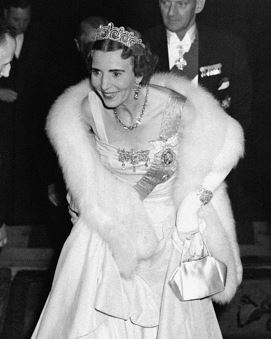
There is a curious tradition amongst the Royal and Aristocratic families of Europe – The Family Tiara.
Either worn by the female members or those marrying in, we often see the same headpiece used at weddings time and time again.
A famous example of this custom was Princess Diana, when she wore The Spencer family tiara for her wedding in 1981 to Prince Charles.
The Danish and Spanish Royal families follow the same pattern and the Greek Royal Family have also adopted this practice by way of the Antique Corsage tiara.

A Corsage is a term used for a large brooch that can be worn on across the front of a dress. The Researcher and Master Jeweller, Pablo Milstein believes that the jewel originated in Prussia during the reign of Frederick the Great. Made from pearls and diamonds, this corsage brooch was part of the collection of Princess Louise of Prussia who became the Grand Duchess of Baden in 1856. In this portrait, you can see the corsage at her waist and other pearl elements in her hat.
After her death in 1923, the Corsage was inherited by her daughter, Queen Victoria of Sweden. It stayed with the Swedish Royal Family until it was given to Princess Ingrid on her marriage to Crown Frederick Prince of Denmark in 1935.






Ingrid wore the Corsage very conventionally, pinning it to the front of her dress and using it as a necklace. Just as she had altered the Danish Ruby Parure, she would go on to convert the Corsage into a tiara with the detachable pendants becoming a pair of Pearl and Diamond earrings.
In doing so, she transformed the Corsage in to a demi parure.

King Frederick and Queen Ingrid had three daughters, Margarethe, Beneditke and Anne Marie. When they turned 18, each princess was given a tiara from the Danish Royal Collection.
Princess Anne Marie’s 18th birthday was important for two reasons. Not only was she coming of age, she was finally old enough to wed her fiancé, King Constantine of Greece. To mark the occasion, her parents held a series of magnificent receptions in Copenhagen and it was there that she chose debut her new tiara.





As the new Queen of the Hellenes, Anne Marie now had access to the Greek Royal jewels and therefore did not wear the Corsage tiara as regularly as some of her more imposing pieces.
She did however wear the demi parure on a state visit to the Vatican in 1966.




Despite not wearing the tiara often, Queen Anne Marie appears to have enjoyed wearing the accompanying Pearl and Diamond earrings.



King Constantine’s reign was, alas, short. After a failed counter coup against the Greek Military dictatorship in 1967, King Constantine and Queen Anne Marie were forced to flee Greece (The Greek monarchy was officially abolished on 1st June 1973). The Greek Royals are closely related to the other royal families of Europe. Queen Anne Marie is the younger sister of Queen Margarethe of Denmark & King Constantine is Queen Sofia of Spain’s brother as well as Prince William’s Godfather. This means that there are still many occasions for these jewels to be worn at.
Both Queen Anne Marie’s daughters, Princess Alexia & Princess Theodora have worn the tiara but it has been Theodora who has been photographed wearing it most frequently. She will often wear the complete demi parure for an event, such as Crown Prince Frederik’s 50th birthday on 26 May 2018.





But the Corsage tiara has also become the de facto wedding for the Greek Royals.
All three of Queen Anne Marie’s daughter in laws have worn the tiara at their weddings with the most recent being Princess Nina in 2021.



Given the Greek Monarchy is now defunct and the Greek Royals will inevitably fade from public view, it will be interesting to see what becomes of this magnificent suite of jewels.
